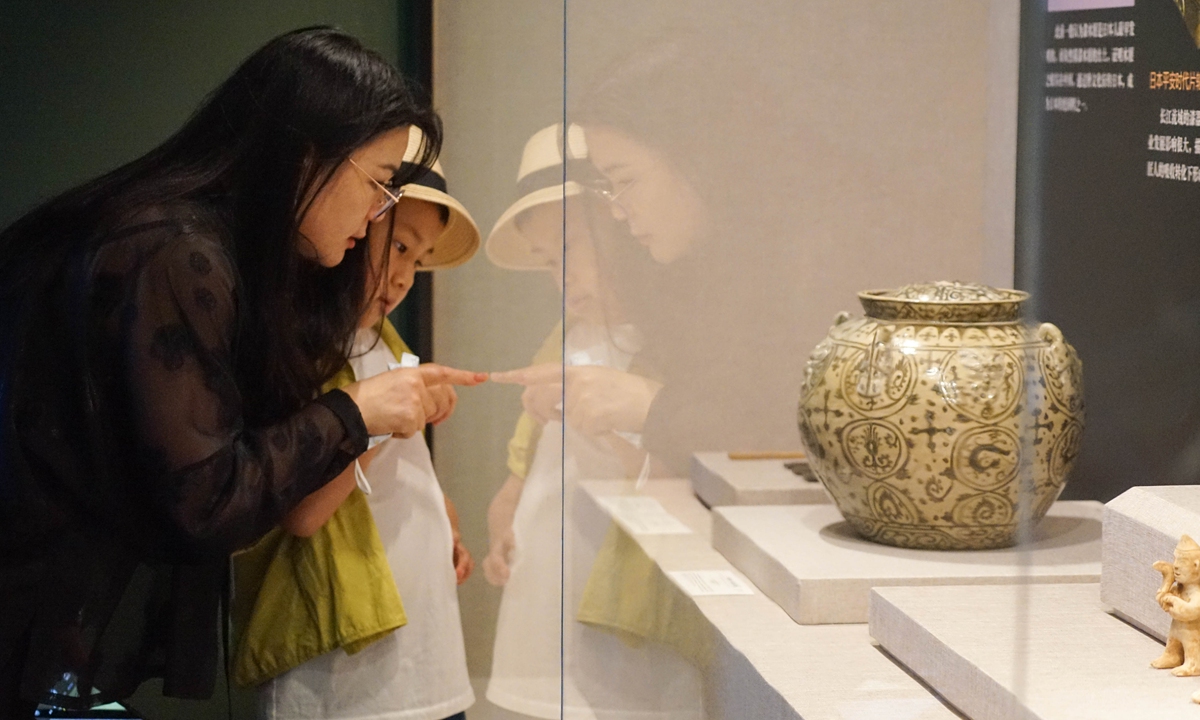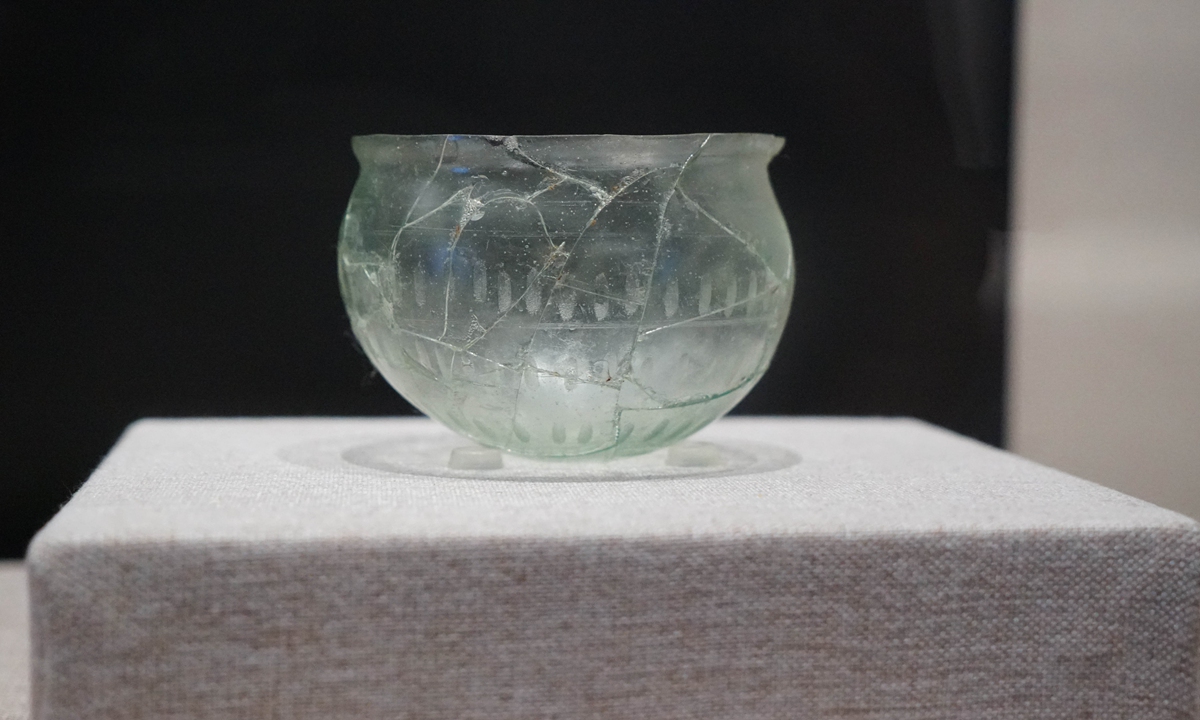
Visitors watch an ancient porcelain pot at the China Maritime Museum in Shanghai, on July 10, 2023. Photo: Lu Ting/Global Times
At a corner of the dark-blue exhibition hall, a bronze statue of a human head unearthed in the upper reaches of the Yangtze River is on display in a vitrine under soft yellow light. A few paces away is a porcelain bowl salvaged from an ancient sunken ship in the lower reaches of the Yangtze River.
The two cultural relics, along with many other exhibits on display, silently tell stories of the development of China's renowned Yangtze River over thousands of years.
A new exhibition themed after the Belt and Road Initiative (BRI), named the
Common Rise of River and Sea: The Yangtze River and Maritime Civilization Exhibition of Fine Archaeological Relics, kicked off at the China Maritime Museum in Shanghai on Monday.
The exhibition has a collection of 180 pieces of precious cultural relics from the catalogues of 41 museums and archaeological institutions in 13 provinces across China.
They, together, show visitors how ancient shipping was conducted and how Yangtze River culture integrated with maritime civilization in history, and how this famous "golden waterway" of China has contributed to the development of the Maritime Silk Road as well as the prosperity of global civilization, Lu Wei, the museum's deputy director, told the Global Times on Monday.
The exhibition will open to the public from Tuesday, which also marks the year 2023's China National Maritime Day.
It is set to run until October 8.
Feast for archaeology loversThe exhibition is a feast for archaeology lovers. With numerous unearthed or salvaged relics, it boasts 34 main archaeological finds from China, 13 of which were on the list of "China's top 100 archaeological finds in the last 100 years."
These great archaeological discovers bear witness to the integration process of the Yangtze River and marine civilizations from the Neolithic Age to present day, Lu noted.
Cai Tingting, the exhibition curator, said that she and her colleagues selected the exhibits either from the areas along the Yangtze River and its tributaries, or the ancient shipwrecks salvaged from China's coastal maritime regions. "We want to methodically show the various regional shipping cultures of the Yangtze River basin, and the forms of communication initiated and sustained between cultures," Cai told the Global Times at a preview on Monday.
She highlighted the bronze drum embossed with a pattern of feathered men aboard ships unearthed in Guangnan county in the exhibition hall. The drum, from the upper reaches of the Yangtze River in Southwest China's Yunnan Province, fashioned during the Western Han Dynasty (206BC-AD25), is one of the greatest treasures of the Yunnan Provincial Museum to date.
The bronze drum features four ship patterns curved on its surface. On the ships, several figures in feathered clothing or hair decorations are seen rowing or dancing. The patterns are a vivid representation of the lives and traditions of the ancient people in Yunnan, including the offering of sacrifices on the water, Cai said.
Another highlight of the exhibition was the lacquer plate with a pattern of Ji Zha hanging up his sword. The plate is so precious and fragile that Chinese cultural heritage authorities put it on the list of the third batch of cultural relics not to be exhibited abroad in 2013.
The plate, from the Three Kingdoms (220-280), was made of a unique lacquerware technique from the ancient Shu Han Kingdom period (221-263), which is believed to have stood where Sichuan Province is today. However, the plate was unearthed not from Shu Han, but from the Wu Kingdom (approximately the present-day Jiangsu, Zhejiang and Anhui provinces) thousands of miles away.
Shu Han and Wu kingdoms were respectively located in the upper and lower reaches of the Yangtze River. "The plate proves that even though the two kingdoms were ruled by different regimes at that time, they maintained exchanges through the Yangtze River," Cai said.
Witnesses to historyThe year 2023 marks the 10th anniversary of the China-proposed BRI. As a BRI-themed cultural project, the exhibition "demonstrates the outstanding contributions that the Yangtze River, the origin of the Chinese civilization, has made to the global civilization," Lu told the Global Times.
As early as the Shang Dynasty (c.1600BC-1046BC) and the Zhou Dynasty (1046BC-256BC), the Yangtze River was an important channel of ancient communication with other countries, although such communication manifested itself as barter trade, said Cai.
"At the 3,000-year-old Sanxingdui Ruins in the upper reaches of the Yangtze River, archaeologists have found many seashells originally from the Indian Ocean," Cai told the Global Times.
In ancient Chinese history, especially after the Maritime Silk Road was created during the Han Dynasty (206BC-AD220), with the economic development of the Yangtze River basin, and the growing trade between China and foreign countries, the Yangtze River became an artery for distributing typical Chinese products including silk and porcelains, abroad, and allowed for the inflow of global treasures as well.
Many cultural relics on display at the exhibition are mere samples of the then flourishing trade and cultural exchanges.
A glass bowl believed to have been made in the Eastern Jin Dynasty (317-420), for instance, was unearthed in Nanjing, East China's Jiangsu Province, the dynasty's capital then. "The bowl was made of a special glass material named 'Sasanian glass,' a typical type of glassware from Persia, meaning it was a product of the remote Central Asia region," Cai explained.

An ancient glass bowl unearthed in Nanjing, East China's Jiangsu Province is on display at the China Maritime Museum in Shanghai. Photo: Lu Ting/Global Times
Through thousands of years, the Yangtze River basin has been characterized by diversity and coexistence, and has been a frontier and highland of cultural exchanges between China and the world, Lu told the Global Times.
"Nowadays, it remains a major link between the Silk Road Economic Belt and the 21st Century Maritime Silk Road, shouldering the new historical mission of supporting 'unimpeded dual circulation of domestic and overseas markets,'" he noted.